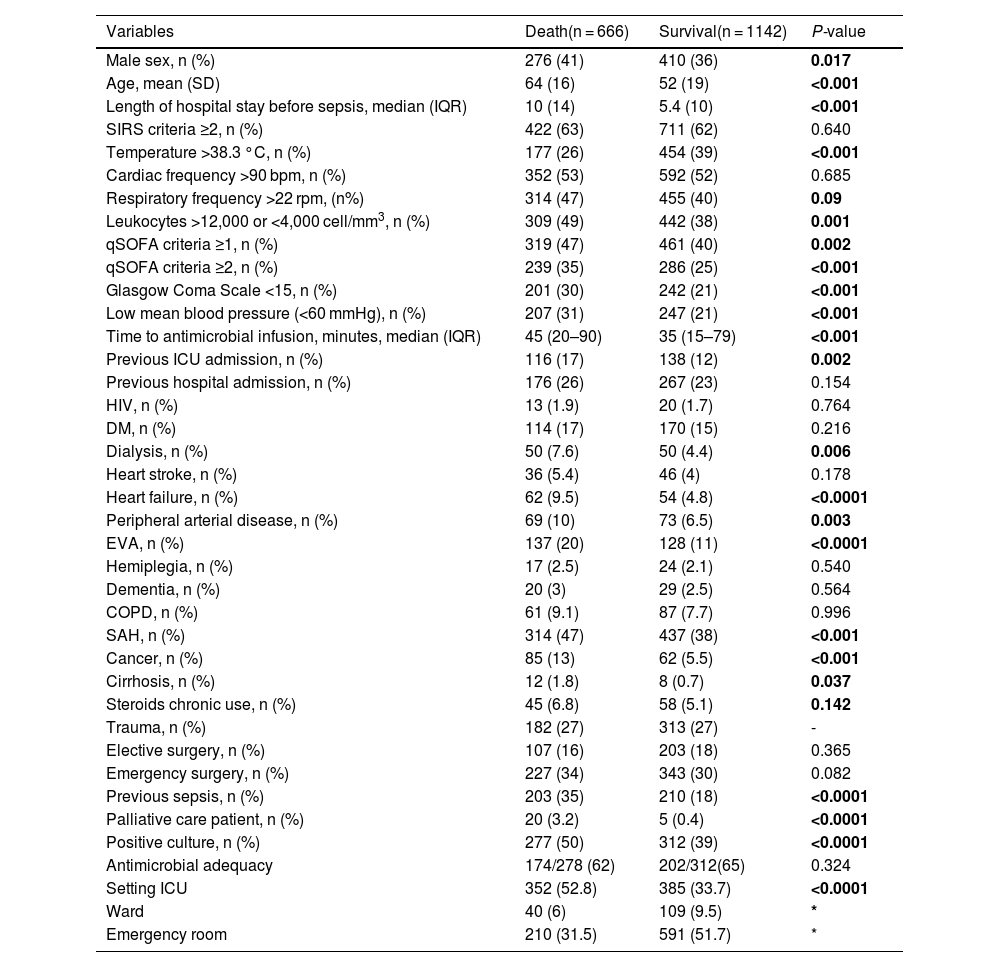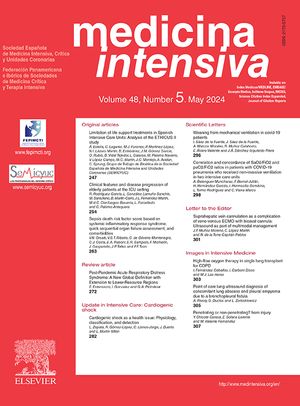In this study, we aimed to evaluate the death risk factors of patients included in the sepsis protocol bundle, using clinical data from qSOFA, SIRS, and comorbidities, as well as development of a mortality risk score.
DesignThis retrospective cohort study was conducted between 2016 and 2021.
SettingTwo university hospitals in Brazil.
ParticipantsPatients with sepsis.
InterventionsSeveral clinical and laboratory data were collected focused on SIRS, qSOFA, and comorbidities.
Main variable of interestIn-hospital mortality was the primary outcome variable. A mortality risk score was developed after logistic regression analysis.
ResultsA total of 1,808 patients were included with a death rate of 36%. Ten variables remained independent factors related to death in multivariate analysis: temperature ≥38 °C (odds ratio [OR] = 0.65), previous sepsis (OR = 1.42), qSOFA ≥ 2 (OR = 1.43), leukocytes >12,000 or <4,000 cells/mm3 (OR = 1.61), encephalic vascular accident (OR = 1.88), age >60 years (OR = 1.93), cancer (OR = 2.2), length of hospital stay before sepsis >7 days (OR = 2.22,), dialysis (OR = 2.51), and cirrhosis (OR = 3.97). Considering the equation of the binary regression logistic analysis, the score presented an area under curve of 0.668, is not a potential model for death prediction.
ConclusionsSeveral risk factors are independently associated with mortality, allowing the development of a prediction score based on qSOFA, SIRS, and comorbidities data, however, the performance of this score is low.
En este estudio, nuestro objetivo fue evaluar los factores de riesgo de muerte de los pacientes incluidos en el protocolo de sepsis, utilizando datos clínicos de qSOFA, SIRS y comorbilidades, así como el desarrollo de un puntaje de riesgo de mortalidad.
DiseñoEste estudio de cohorte retrospectivo se llevó a cabo entre 2016 y 2021.
ÁmbitoDos hospitales universitarios en Brasil.
ParticipantesPacientes con sepsis.
IntervencionesSe recopilaron varios datos clínicos y de laboratorio centrados en SIRS, qSOFA y comorbilidades.
Variable de interésprincipalesLa mortalidad intrahospitalaria fue la variable de resultado primaria. Se desarrolló un puntaje de riesgo de mortalidad después del análisis de regresión logística.
ResultadosSe incluyeron un total de 1,808 pacientes con una tasa de mortalidad del 36%. Diez variables permanecieron como factores independientes relacionados con la muerte en el análisis multivariado: temperatura ≥38 °C (odds ratio [OR] = 0.65), sepsis previa (OR = 1.42), qSOFA≥2 (OR = 1.43), leucocitos >12,000 o <4,000 células/mm3 (OR = 1.61), accidente cerebrovascular encefálico (OR = 1.88), edad >60 años (OR = 1.93), cáncer (OR = 2.2), duración de la estancia hospitalaria antes de la sepsis >7 días (OR = 2.22), diálisis (OR = 2.51) y cirrosis (OR = 3.97). Considerando la ecuación del análisis de regresión logística binaria, el puntaje presentó un área bajo la curva de 0.668, un modelo débil para la predicción de la muerte.
ConclusionesVarios factores de riesgo se asocian de forma independiente con la mortalidad, lo que permite el desarrollo de una puntuación de predicción basada en datos de qSOFA, SIRS y comorbilidades; sin embargo, el rendimiento de esta puntuación es bajo.
Article
Go to the members area of the website of the SEMICYUC (www.semicyuc.org )and click the link to the magazine.










